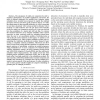Free Online Productivity Tools
i2Speak
i2Symbol
i2OCR
iTex2Img
iWeb2Print
iWeb2Shot
i2Type
iPdf2Split
iPdf2Merge
i2Bopomofo
i2Arabic
i2Style
i2Image
i2PDF
iLatex2Rtf
Sci2ools
109
click to vote
PDP
2010
IEEE
2010
IEEE
Malleable-Lab: A Tool for Evaluating Adaptive Online Schedulers on Malleable Jobs
—The emergence of multi-core computers has led to explosive development of parallel applications and hence the need of efficient schedulers for parallel jobs. Adaptive online schedulers have recently been proposed to exploit the multiple processor resource and shown good promise in theory. To verify the effectiveness of these parallel schedulers, it will be reassuring to test them extensively with various parallel workloads. Unfortunately it is still unknown how the job mixes will eventually evolve for multi-core computers; moreover, it is also non-obvious how the parallelism of a typical job will look like. To evaluate the dynamic behaviors of an adaptive scheduler under various scenarios, an ideal workload model for schedulers should thus allow the user to vary parallelism profiles of individual jobs as well as the job arrival patterns. In this paper, we present a tool called Malleable-Lab, which models malleable parallel jobs by extending the traditional moldable job models. Ins...
Adaptive Online Schedulers | Distributed And Parallel Computing | Online Schedulers | Parallel Jobs | PDP 2010 |
| Added | 14 Aug 2010 |
| Updated | 14 Aug 2010 |
| Type | Conference |
| Year | 2010 |
| Where | PDP |
| Authors | Yangjie Cao, Hongyang Sun, Wen-Jing Hsu, Depei Qian |
Comments (0)

